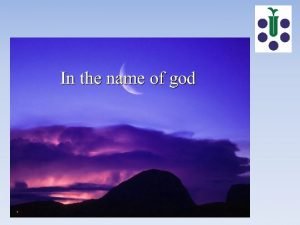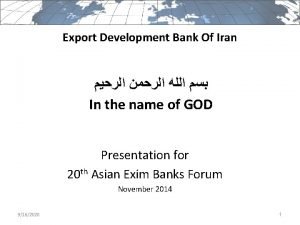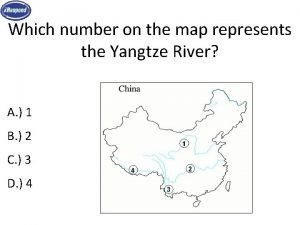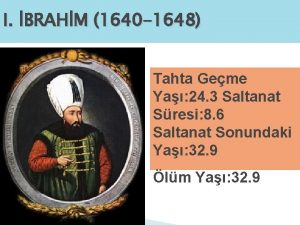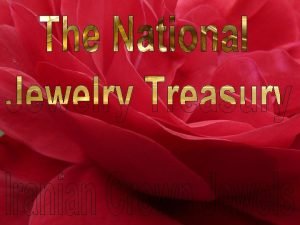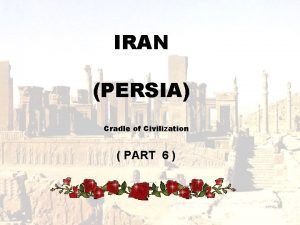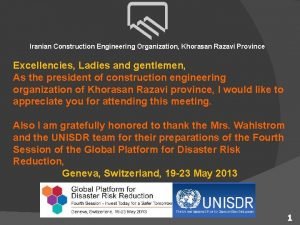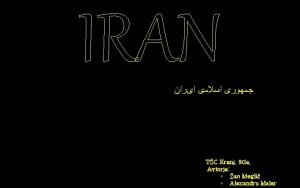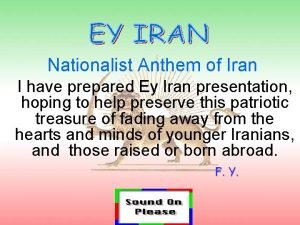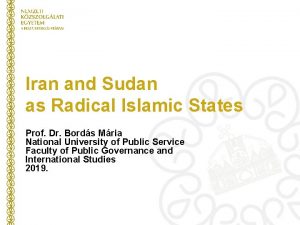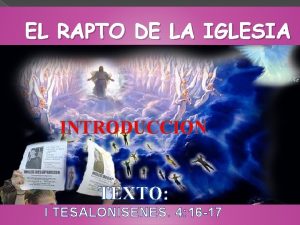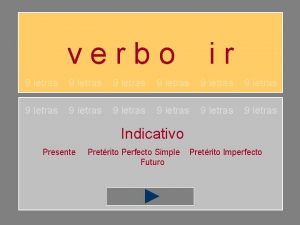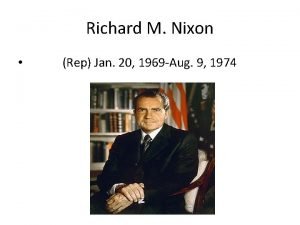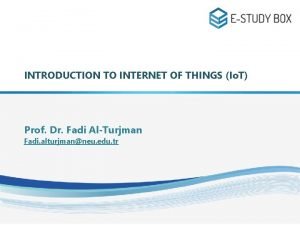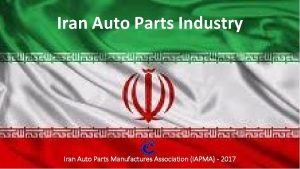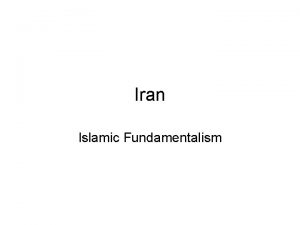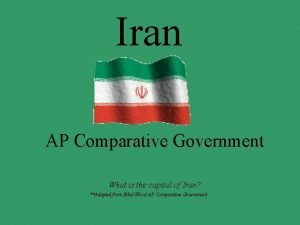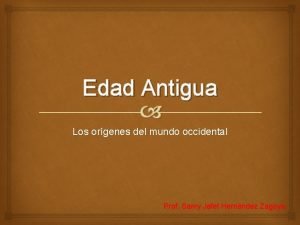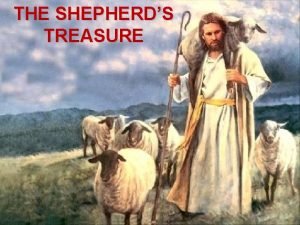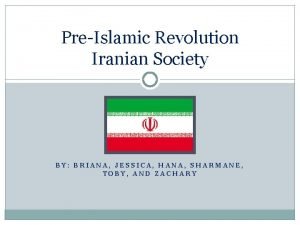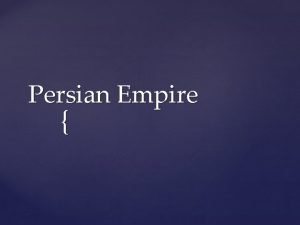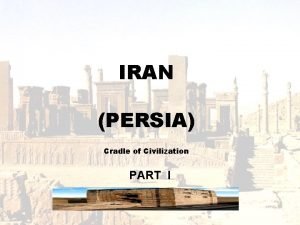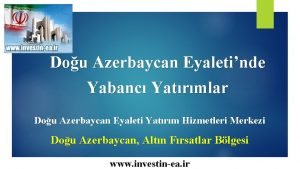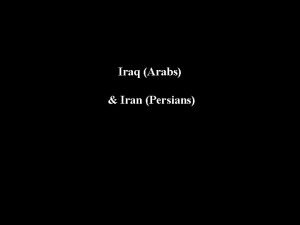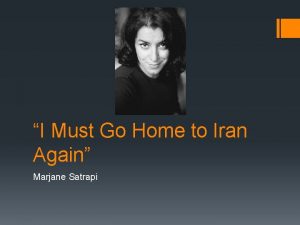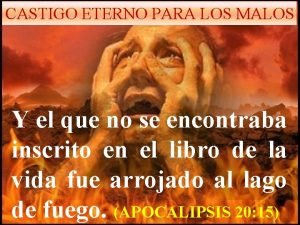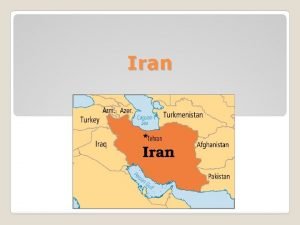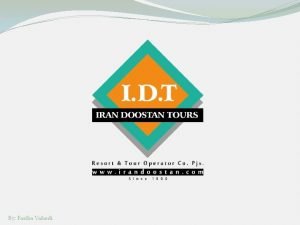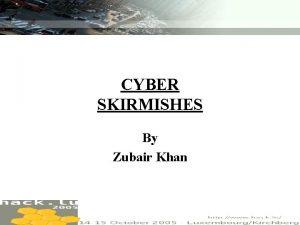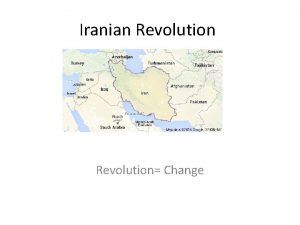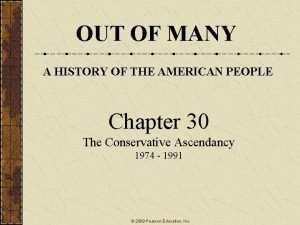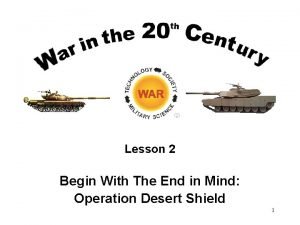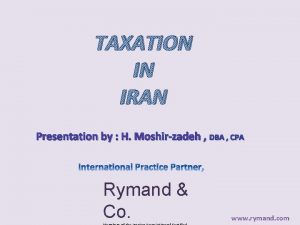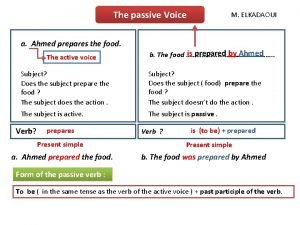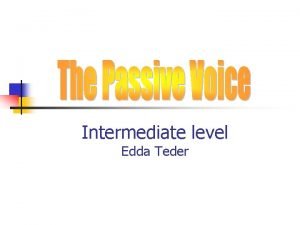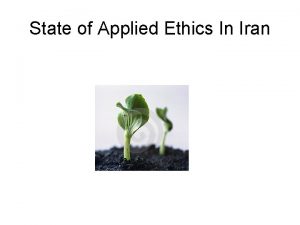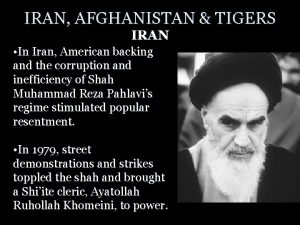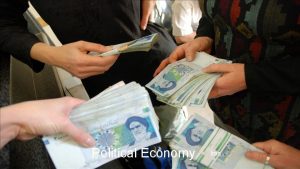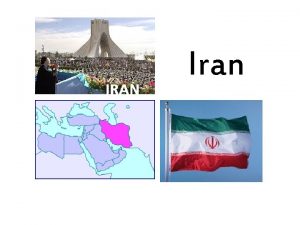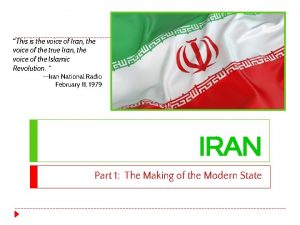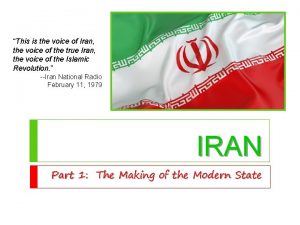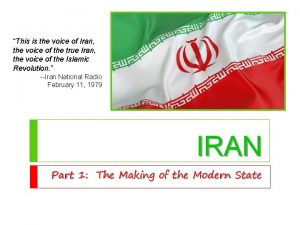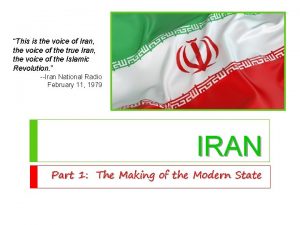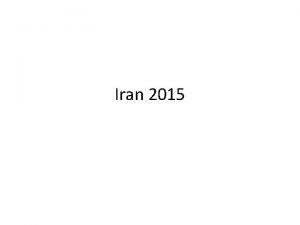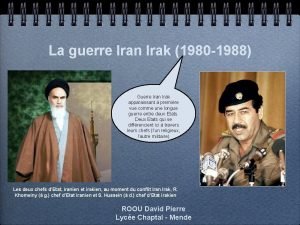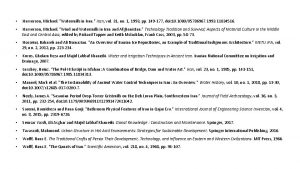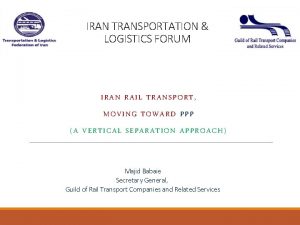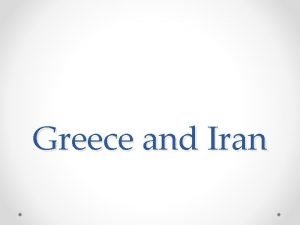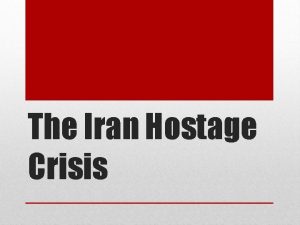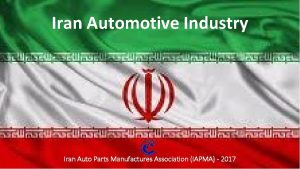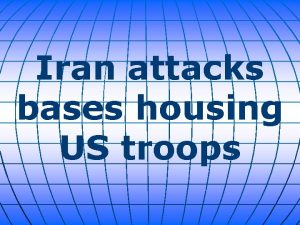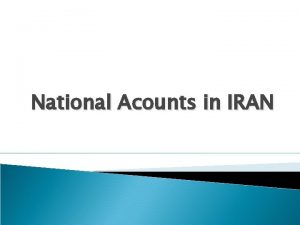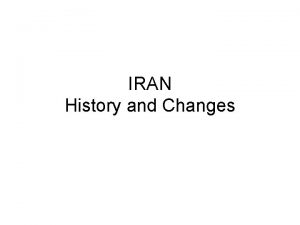This is the voice of Iran the voice













































































- Slides: 77

“This is the voice of Iran, the voice of the true Iran, the voice of the Islamic Revolution. ” --Iran National Radio February 11, 1979 IRAN Part 1: The Making of the Modern State

Why Study Iran? Table talk 3 minutes. . . come up w/ 3 reasons

Why Study Iran? ▶ ▶ World’s only theocratic republic Theocracy with democratic elements Unique among Middle Eastern countries Tradition versus modernization

Geography ▶ Crossroads between: ▶ ▶ ▶ ▶ Central Asia and Asia Minor Indian subcontinent and the Middle East Arabian Peninsula and the Caucasus Mountains Historically vulnerable to invaders Slightly larger than Alaska Much of territory inhospitable to agriculture 2 nd largest oil producer in the Middle East and 4 th largest in the world Urbanized and partly industrialized

Population ▶ ▶ 67% of population on 27% of land Persian country, NOT Arab 89% Shi’a Muslim 58% speak Farsi (Persian)

Population ▶ Iran has a large young population ▶ ▶ 24% of all Iranians are under 15 and 27 is median age (was 23!) Youth bulge is evident in many nations in region


Population ▶ Discussion Question: What future problems might Iran need to address based on this population pyramid? Why is Iran now promoting population growth?

Sunni v. Shiite Sunni Shiites Majority of population in most Muslim countries Majority in Iran, Iraq, Bahrain, possibly Lebanon “Followers of tradition” “Partisans of Ali (son-in-law)” Most prominent members of community should select new leader, 4 caliphs (and heirs), based on piety, wisdom, morality, leadership ability, competence; ruled continuously until breakup of Ottoman Empire at end of WWI Leadership should be based on bloodlines to Muhammad…all the way to Twelfth (Hidden) Imam who went into hiding; his return will herald end of the world Any religious educated person can rule Senior clerical scholars (ayatollahs) should interpret Shari’a until Twelfth Imam returns What's the Difference?


History – Safavids & Qajars ▶ ▶ Safavids (1501 -1722) conquered Iran in 16 th century Forcibly converted their subjects to Shi’ism ▶ ▶ ▶ Rulers claimed to be descendants of 12 Imams Tolerated religious minorities Qajars (1794 -1925) ▶ ▶ A Turkish tribe takes power after invasion and civil war Move capital to Tehran Declare Shi’ism to be state religion; clerical leaders interpreters Economic troubles during time of imperialism*

History – Introduction of Democracy ▶ ▶ Constitutional Revolution (1905 -1909) Constitution of 1906 ▶ ▶ ▶ Direct elections Separation of powers Laws made by elected legislature ▶ ▶ ▶ Very strong – controlled cabinet members Popular sovereignty Bill of Rights Retained Shiism as official religion Created Guardian Council of clerics ▶ veto power

History – The Pahlavi Dynasty (1925 -1979) ▶ 1921 - Reza Shah carried out coup d’etat ▶ ▶ 1941 son, Muhammad Reza Shah took power in 1941 ▶ ▶ ▶ 4 years later named himself “shah-in-shah” (king of kings) Ruled with iron fist; Majles (name of parliament) lost its power Changed name from Persia to Iran; allied with Nazis formed SAVAK (Secret Police. . . like KGB or CIA) authoritarian regime Rise of the National Front (opposition) ▶ ▶ ▶ Led by Muhammad Mosaddeq Drew support from middle class Emphasized Iranian nationalism

History – the 1953 Coup ▶ Mosaddeq advocated nationalizing the British owned-company that monopolized Iran’s oil business ▶ ▶ ▶ Elected Prime Minister in 1951 ▶ ▶ Supported by Tudeh – Communist Party Also wanted to take armed forces out from under shah’s control Power grew & forced shah to flee country in 1953 British and U. S. orchestrated overthrow of Mosaddeq & restored shah to power…Why?

History – Muhammad Reza Shah ▶ Westernization/Secularization of Iranian culture ▶ White Revolution: gave cleric land to peasants, extended women’s rights, reduced clerical influence; increased secularism ▶ Rentier state ▶ ▶ Industrialization ▶ ▶ Iran received an increasing amount of income by exporting its oil Income so great that by 1970 s govt no longer relied on internal taxes for support Paid most of its expenses through oil income Rapidly industrialized from oil revenue Centralization

History – Muhammad Reza Shah ▶ Discussion Question: Can a government that doesn't depend upon its constituents for income (rentier state) really be representative or legitimate?

History – Muhammad Reza Shah ▶ The Shah’s Downfall: ▶ ▶ ▶ Became more distant from people over the years Became very wealthy Ignored civil liberties Stifled newspapers, political parties, and professional associations Alienated clergy, intelligentsia, and urbanites Overstepped bounds of political culture: ▶ ▶ ▶ Perceived as being totalitarian Secularized too fast Offended nationalists and clergy with ties to west (particularly U. S. )

History – 1979 Revolution ▶ Triggers: ▶ ▶ ▶ Oil prices decreased by 10% and consumer prices increased 20% Revolution of rising expectations U. S. put pressure on shah to loosen restraints on opposition ▶ ▶ ▶ Organized and led by clerics, but broadly supported by many sectors Charismatic leader – Ayatollah Ruhollah Khomeini ▶ ▶ Encouraged others to voice frustrations In exile in Paris, but speeches were influential Shah fled country in Feb 1979

Founding of the Islamic Republic - 1979 ▶ ▶ ▶ April 1979 national referendum was held – voted out monarchy established Islamic Republic Established a new constitution Ayatollah Khomeini (Supreme Leader) Islamic fundamentalism Jurist’s guardianship (valeyat-efaqih): ▶ ▶ Gave senior clergy (Grand ayatollahs) all-encompassing authority over the whole community—not just widows, minors, and mentally disabled Only senior clerics could interpret Shari’a Law

Crash Course Video - Iran https: //www. youtube. com/watch? v=8 w 4 Ku 6 l 7 OEI

Iran Hostage Crisis ▶ ▶ American embassy hostages held for 444 days from 1979 -1981 Believed that purpose could be to undercut PM Bazargan

Cultural Revolution ▶ ▶ Launched by Shia leaders after revolution Aimed to purify the country from the shah’s regime, secular values, and western influences Purged universities of liberals Suppressed all opposition

Iran-Iraq War (1980 -88) ▶ ▶ ▶ Started when Iraq invaded Iran by land air People rallied around the govt in response Ended in 1988 with a UN-brokered cease-fire

Post-Khomeini (1989 -Present) ▶ ▶ ▶ Khomeini died in 1989 Ayatollah Ali Khamenei (1989 -Present) President - Hashemi Rafsanjani (1989 – 1997) ▶ Moderate ▶ Concerned with reforming slumping economy due to theological commitments and war with Iraq ▶ Very few reforms

Post-Khomeini (1989 -Present) ▶ President Mohammad Khatami (1997 -2005) ▶ ▶ ▶ ▶ Reformist and surprise winner Easier to organize political groups Less censorship of press Tried to improve relations with US and other Western countries Reformist Khatami was left isolated by conservative resurgence Hard line conservatives disqualified moderates from 2004 parliamentary elections

President Ahmadinejad (2005 -2013) ▶ President Mahmoud Ahmadinejad (2005 -2013) ▶ ▶ ▶ Tehran's ultra-conservative mayor Won a run-off vote in presidential elections in 2005 First non-cleric president in 24 years


2009 Presidential Election ▶ ▶ ▶ Huge push for reformist candidate Mousavi to be beat Ahmadinejad Close race – 85% Turnout Allegations of fraud were strong – Mousavi urged his supporters to the streets Khamenei agreed to an investigation Huge protests/Government Crackdown


President Ahmadinejad (2005 -2013) ▶ ▶ ▶ ▶ ▶ Council of Guardians rejected candidacies of popular reformers Several major reformist newspapers closed Journalists and civil society activists arrested Jailed internet users who spread information “aimed at disturbing the public mind” Morality police and vigilantes to enforce Islamic dress codes & prevent public mingling of men and women Increasing reports of arrest, torture, and executions Sharia more strictly enforced Called for destruction of Israel Questioned reality of Holocaust Increased nuclear fuel research

Current ▶ President Rouhani (Elected 2013) ▶ ▶ ▶ Moderate cleric How did he win? What does this mean?



Review: Crash Course

▶ IRA N Part 2: Governance & Policymaking

The Basics ▶ Theocratic Republic ▶ ▶ Theocratic Institutions: ▶ ▶ ▶ Theocracy with democratic elements Supreme Leader Guardian Council Assembly of Religious Experts Expediency Council Highly Centralized Unitary State But is divided administratively into provinces, districts, sub-districts, and local areas (local elections allowed since 1999) ▶ Dual Executive (HOS, Supreme Leader; HOG, President) ▶ ▶ ▶ Unicameral Legislature Judiciary not independent; Based on Sharia Law

37

The Supreme Leader (Head of State) ▶ ▶ ▶ Currently: Ayatollah Ali Khamenei Most powerful political figure Chosen by the clerics who make up the Assembly of Experts Appointed for Life Expected to act as a trustee of community by supervising politics and ensuring laws conform to Islam ▶ Faqih – leading Islamic jurist to interpret the meaning of religious documents/sharia law

The Supreme Leader ▶ ▶ He links 3 branches of gov’t together Powers: ▶ ▶ ▶ ▶ Limit Presidential candidates Authority to overrule/dismiss president Command of armed forces Declaration of war and peace Issue decrees for national referenda Appoint head of judiciary Appoint half of the members of the Guardian Council Appoint Friday prayer leaders and the head of radio and TV


The Guardian Council ▶ 12 (all male) member council, serve 6 year terms ▶ ▶ 6 clerical members appointed by supreme leader 6 lay members (lawyers) recommended by head of judiciary, subject to approval of parliament Council has power to veto any legislation passed by parliament that is at odds with basic tenants of Islam Vetting Power ▶ ▶ Has right to determine who can run in local, presidential, parliamentary, and Assembly of Religious Experts elections 2012/13: they disqualified thousands of candidates for

The Assembly of Religious Experts ▶ 86 members (no females) ▶ ▶ ▶ Directly elected by people for 8 year terms Elects Supreme Leader & has right to dismiss him Candidates are subject to approval by Guardian Council



The Expediency Council ▶ 32 members appointed by Supreme Leader Includes President, chief judge, speaker of the Majles, jurists from Guardian Council Serve 5 year terms Designed to settle disputes between Majles and Guardian Council May originate its own legislation ▶ Why might this be a concern? ? ▶ ▶


The President ▶ ▶ ▶ Head of Government Currently: Hassan Rouhani 4 year term 8 -year consecutive term limit Directly elected by the people ▶ ▶ Universal suffrage (18 or older) Absolute majority of votes Top two run a week later Candidates approved by Guardian Council ▶ ▶ 2005 Election disqualified 1, 000 candidates (left only 7 to run) 2009 Election – Accusations/Protests about voter fraud


The President ▶ Qualifications: ▶ ▶ ▶ Between ages of 25 and 75 “Well-known personality clause” in constitution allows Guardian Council to bar women “Shi’ite sect” qualification bars Sunni Muslims, Christians, Jews, Zoroastrians and other religious minorities ▶ ▶ Historically a cleric, but not Ahmadinejad Powers: ▶ ▶ ▶ Selects vice presidents & cabinet members Devises budget & presents legislation to parliament Signs treaties, laws & agreements Chairs National Security Council Appoints provincial governors, town mayors & ambassadors

The Bureaucracy ▶ ▶ Headed by President Grown since the revolution Dominated by clergy Most important ministries: ▶ ▶ Culture and Islamic Guidance (controls media and enforces “proper conduct” in public life) Intelligence (replaced shah’s SAVAK) Heavy Industries (manages nationalized factories) Reconstruction (expands social services and takes “true Islam” to countryside)

The Legislature/Majles ▶ 290 deputies, 4 year terms, SMD ▶ ▶ ▶ Five guaranteed seats for recognized religious minorities: Christians, Jews, and Zoroastrians Nonrecognized religious minorities (e. g. , Baha’is) cannot run Direct Elections ▶ ▶ ▶ Elections held on a nonpartisan basis (ballots do not have party identification or philosophy) 28 multimember districts (based on population size) Two round voting: ▶ ▶ Candidate must receive at least 25% on first ballot If more candidates clear this threshold to fill a district’s seats: second round held several months later for top two candidates with the most support




The Legislature/Majles ▶ Qualifications ▶ ▶ ▶ Candidates submit their names to subcommittee of Guardian Council, which determines who can run Age 30 -75 Those running for first time must have equivalent of university degree

The Legislature/Majles ▶ ▶ NOT a rubber-stamp institution Powers ▶ ▶ ▶ Enact/Change laws (with approval of Guardian Council) Appoint 6 of 12 members of Guardian Council, chosen from a list drawn up by chief judge Investigate cabinet ministers and public complaints against executive and judiciary Remove cabinet members (not president) Approve budget, cabinet appointments, treaties & loans

The Judiciary ▶ ▶ ▶ Based on Sharia (Islamic) Law – supersedes all other Qanun – law passed by the Majles – may not contradict Sharia Law Not independent Supreme leader appoints head of judiciary who appoints senior judges Penal Code (Retribution Law)—very strict/harsh ▶ ▶ ▶ Stoning, death penalty for many “crimes” (adultery, homosexuality, habitual drinking) Evidence of one male Muslim = evidence of two female Muslims Modernized penalties, but high rate of executions

The Military ▶ ▶ ▶ Regular army of 370, 000 According to Constitution, regular army defends the borders, while the Revolutionary Guards protect the republic Revolutionary Guards (est after 1979) ▶ ▶ 125, 000 active troops, commanders appointed by Supreme Leader Has its own ground forces, navy and air force, and oversees Iran's strategic weapons. Controls the volunteer paramilitary Basij Resistance Force Control around a third of Iran's economy through a series of subsidiaries and trusts

Bonyads (Charitable Foundations) ▶ Autonomous (directed by clerics/appointed by Supreme Leader) tax exempt charity organizations that control large amounts of money ▶ ▶ Foundation for the Oppressed & Disabled Martyrs Foundation Most supervise property and state owned businesses After the Revolution, they were nationalized ▶ Supposed to redistribute income to poor and families of martyrs (i. e. those killed in the service of the country) Over 100; Monopolize many sectors of the economy (e. g. , cement, sugar) • Patronage-oriented holding companies that ensure the channeling of revenues to groups and milieus supporting the regime •

How Do Mercantilist State Achieve Economic Power? -Directing the economy towards certain industries and away from others through the use of taxation and subsidies. -Through partial or full state ownership of industries that are considered critical. Known as parastatals. -Strong use of tariffs and non-tariff barriers such as regulations to imports. -Low interest rates set by the central bank to encourage borrowing and investment.

How Do Mercantilist State Achieve Economic Power? -Directing the economy towards certain industries and away from others through the use of taxation and subsidies. -Through partial or full state ownership of industries that are considered critical. Known as parastatals. -Strong use of tariffs and non-tariff barriers such as regulations to imports. -Low interest rates set by the central bank to encourage borrowing and investment.

Linkage Institutions – Political Parties ▶ ▶ Constitution gives citizens the right to organize/assemble Constitution allows political parties, but they did not emerge until after 1997 election of Khatami ▶ ▶ Weak parties have formed – organized around personalities Parties are unstable & change from election to election Two major coalitions: Conservative vs Reformist Parties led by former dissidents (leaders are in exile)

Linkage Institutions – Interest Groups ▶ ▶ Very weak Workers House – one of the few prominent interest groups in Iran ▶ ▶ ▶ Factory workers Reform minded Few business interest groups have formed – the Iranian government controls between 65%-80% of the economy

Linkage Institutions – Mass Media ▶ Speech against the government was a criminal offense after the 1979 revolution ▶ ▶ ▶ Major radio and TV is gov’t-run by the Islamic Republic of Iran Broadcasting ▶ ▶ ▶ Some of these have been lifted over time Still a major issue between conservatives & reformers (in terms of access to media/what info is shared by media, etc) Some newspapers and magazines are privately owned Most are non-political (more scholarly) All publications must have licenses from gov’t – can be revoked at any time; every website must be registered Since 2010, the gov’t has been building a national network as a substitute for the Internet Social Media sites from outside of Iran are normally not accessible

Review ▶ Discussion Question: What elements of Iran’s political system make it theocratic? Which elements make it democratic? Theocratic Democratic

IRAN Part 3: Citizens, Society, & the State

Cleavages ▶ Religion ▶ ▶ ▶ 90% are Shia Muslim 10% are Sunni Muslim <1% = Jews, Christians, Zoroastrian, Ba’hai Although the constitution recognizes religious minorities (not Sunnis) and protects their rights, many fled the country since the founding of the Islamic Republic in 1979 The Ba’hai faith has suffered persecution ▶ ▶ ▶ Seen as an unholy offshoot of Islam Leaders have been executed, imprisoned, tortured Their schools have been closed and their community property taken by the state

Cleavages ▶ Ethnicity ▶ ▶ ▶ Azeris live in NW close to Azerbaijan ▶ ▶ ▶ 51% Persian 24% Azeri 8% Gilaki and Mazandarani 7% Kurds; 3% Arabi Iran worries Azeris will want to form larger state by taking away territory from Iran Azeris do not speak Persian, BUT are strongly Shiite; (Supreme Leader is Azeri) Kurds & Arabs tend to be Sunni Muslim

Cleavages ▶ Social Class ▶ ▶ ▶ Peasantry and lower middle class are sources of support for the regime Partly b/c they have benefitted from the government’s special programs that have provided them with electricity & paved roads Middle and upper-middle class are largely secularized ▶ ▶ Tend to be critical of clerics and their control of society Reinforced by the fact that many middle class people have not fared well economically since founding of Republic

Cleavages ▶ ▶ Reformers v. Conservatives: ▶ ▶ Want to keep the regime under control of clerics/sharia law Reformers: ▶ ▶ Want to see more secularization and democracy Most reformers do NOT want to do away with basic principles of an Islamic state; but vary on how much and where secularization & democracy should be infused into system

Cleavages ▶ Pragmatic Conservatives v. Radical Clerics ▶ Pragmatic Conservatives: ▶ ▶ Clergy that favor liberal economic policies that encourage free markets Radical Clerics: ▶ Call for measures to enhance social justice, esp in terms of providing welfare benefits in Iran’s poor

Civil Society ▶ ▶ Suppressed under Pahlavi shahs and still under Republic Under presidency of Khatami, Iranians experienced some loosening of freedom of speech and press, but didn’t last long Under Ahmadinejad, gov’t closed down newspapers, banned/censored books & websites and did no tolerate peaceful demonstrations and protests Currently, some indication of minimal civil society may be found among Iran’s growing number of young people ▶ Many are sons/daughters of disillusioned middle-class professionals; are very attracted to western popular

Protests & Demonstrations ▶ ▶ ▶ 1999 – protests erupted in universities all across the country when the gov’t shut down a reformist newspaper 2002 – demonstrations by students when courts ruled a death sentence for a reformist academic 2003 – student mass protests over privatization of university system 2007 – security forces attacked striking bus drivers in Tehran/arrested hundreds 2007 – police beat hundreds of men/women who assembled to commemorate International Women’s Day

Protests & Demonstrations ▶ The 2009– 10 Iranian Election Protests ▶ ▶ A series of protests following the 2009 Iranian presidential election against the disputed victory of Iranian President Mahmoud Ahmadinejad and in support of opposition candidates Mir-Hossein Mousavi and Mehdi Karroubi Called the Green Movement after Mousavi’s campaign colors Gov’t sent tens of thousands of Revolutionary Guards and Basij to disperse crowds; violence followed; death toll disputed Ayatollah Khamenei declared that society had been “vaccinated” against these “germs”


Women & the Political System ▶ ▶ ▶ Granted the right to vote in 1963 First admitted into Iranian universities in 1937 Women can run for seats in Majles (about 3%), but are constitutionally barred for the presidency ▶ ▶ ▶ The constitution states that “the president will be elected from religious-political men, or "rijal, " a plural for man in Arabic” Well represented in some areas: doctors and government employees But very difficult to get hired – represent 33% of labor force

Women & the Political System ▶ ▶ ▶ The Islamic Republic calls its policy toward women “equalitywith-difference” Means divorce and custody laws follow Islamic standards that favor males Women must wear scarves and long coats in public ▶ ▶ Must wear hijab; “bad hijab” is the exposure of any body part except for the hands or face; Punishable by either 70 lashes or 60 days in prison Women cannot leave the country without the consent of male relatives Occasional stoning of women for adultery has taken place, though gov’t recently issued a ban on them Ban on public discussion of women’s issues in a way that contradicts Islamic law
 The voice iran
The voice iran Alborz darou pharmaceutical co
Alborz darou pharmaceutical co Export development bank of iran
Export development bank of iran The number 4 on the map represents the country of
The number 4 on the map represents the country of Lehistan günümüzde neresi
Lehistan günümüzde neresi Persian crown jewels
Persian crown jewels Abdollah arefkia
Abdollah arefkia Local guide program
Local guide program Language in iran
Language in iran Kranj prebivalstvo
Kranj prebivalstvo Ey iran national anthem
Ey iran national anthem Mosadek iran
Mosadek iran Rapto de la iglesia
Rapto de la iglesia Verbos 9 letras
Verbos 9 letras William knox d'arcy
William knox d'arcy Squeeky fromme
Squeeky fromme Iot iran
Iot iran Razboiul iran irak
Razboiul iran irak Iran auto parts
Iran auto parts Iran cat map
Iran cat map Iran ap comparative government
Iran ap comparative government Sistagma
Sistagma Where did the shepherd live in iran?
Where did the shepherd live in iran? Iran religion
Iran religion Satrapy of iran
Satrapy of iran Parsi language
Parsi language Azerbaycan yüzölçümü
Azerbaycan yüzölçümü Iran
Iran I must go home to iran again
I must go home to iran again Pasar por verguenza o por miedo al castigo eterno
Pasar por verguenza o por miedo al castigo eterno What was iran known as before 1935
What was iran known as before 1935 Doostan chat
Doostan chat Iran cyber
Iran cyber Savak iran
Savak iran Oliver north iran contra affair
Oliver north iran contra affair Iran hostage crisis timeline
Iran hostage crisis timeline Dba iran
Dba iran What is the pattern of passive voice?
What is the pattern of passive voice? Voice in grammar
Voice in grammar Passive voice tenses chart
Passive voice tenses chart Passive voice vs active voice
Passive voice vs active voice Passive voice converter machine
Passive voice converter machine Passive voice
Passive voice Trời xanh đây là của chúng ta thể thơ
Trời xanh đây là của chúng ta thể thơ ưu thế lai là gì
ưu thế lai là gì Gấu đi như thế nào
Gấu đi như thế nào Thẻ vin
Thẻ vin Cái miệng nó xinh thế chỉ nói điều hay thôi
Cái miệng nó xinh thế chỉ nói điều hay thôi Các châu lục và đại dương trên thế giới
Các châu lục và đại dương trên thế giới Thế nào là hệ số cao nhất
Thế nào là hệ số cao nhất Từ ngữ thể hiện lòng nhân hậu
Từ ngữ thể hiện lòng nhân hậu Diễn thế sinh thái là
Diễn thế sinh thái là Tư thế ngồi viết
Tư thế ngồi viết Thế nào là giọng cùng tên
Thế nào là giọng cùng tên Mật thư anh em như thể tay chân
Mật thư anh em như thể tay chân Chụp tư thế worms-breton
Chụp tư thế worms-breton Khi nào hổ mẹ dạy hổ con săn mồi
Khi nào hổ mẹ dạy hổ con săn mồi đại từ thay thế
đại từ thay thế Vẽ hình chiếu vuông góc của vật thể sau
Vẽ hình chiếu vuông góc của vật thể sau Thơ thất ngôn tứ tuyệt đường luật
Thơ thất ngôn tứ tuyệt đường luật Thế nào là mạng điện lắp đặt kiểu nổi
Thế nào là mạng điện lắp đặt kiểu nổi Các châu lục và đại dương trên thế giới
Các châu lục và đại dương trên thế giới Lời thề hippocrates
Lời thề hippocrates Bổ thể
Bổ thể Dạng đột biến một nhiễm là
Dạng đột biến một nhiễm là Vẽ hình chiếu đứng bằng cạnh của vật thể
Vẽ hình chiếu đứng bằng cạnh của vật thể Quá trình desamine hóa có thể tạo ra
Quá trình desamine hóa có thể tạo ra Làm thế nào để 102-1=99
Làm thế nào để 102-1=99 Chúa sống lại
Chúa sống lại Sự nuôi và dạy con của hổ
Sự nuôi và dạy con của hổ điện thế nghỉ
điện thế nghỉ Thế nào là sự mỏi cơ
Thế nào là sự mỏi cơ Cong thức tính động năng
Cong thức tính động năng Thiếu nhi thế giới liên hoan
Thiếu nhi thế giới liên hoan Hát kết hợp bộ gõ cơ thể
Hát kết hợp bộ gõ cơ thể Tỉ lệ cơ thể trẻ em
Tỉ lệ cơ thể trẻ em Tia chieu sa te
Tia chieu sa te

